Good start for new L.A. River project
July 13, 2011
 Weedy and industrial, the concrete channel near the football field at Canoga Park High School scarcely looks like a notable site.
Weedy and industrial, the concrete channel near the football field at Canoga Park High School scarcely looks like a notable site.
But the spot where Calabasas Creek meets Bell Creek—be it ever so humble—is actually a landmark: the beginning of the Los Angeles River. And this week, it came a big step closer to getting the kind of makeover that would allow it to finally shine.
The Board of Supervisors accepted a $1.97 million state grant to help launch construction of the Los Angeles River Headwaters Project, which eventually will create more than a mile of recreational trails at the point where the storied urban river starts near Canoga Park High School in the San Fernando Valley.
Tentatively scheduled for completion in 2013, the Headwaters Project is part of a larger plan to reclaim and revitalize the river, which runs for some 50 miles through 13 cities, including Los Angeles, before it empties into the ocean at Long Beach. (Click here for an artist’s rendering of the project.)
The grant, authorized under the Proposition 84 state park program and awarded by the California Natural Resources Agency, will be a substantial down-payment on the headwaters improvement, which is expected to add some $9.3 million worth of pedestrian paths, landscaping, signage, water quality improvements and decorative fencing to an area now closed to the public and mostly used for flood control and maintenance.
Officials from the county Department of Public Works say it is the first of several grants for which they’ve applied in the hope of mitigating the cost of the project. And, they note, the City of Los Angeles has applied for an additional Metropolitan Transportation Authority grant to add a bike path to the area.
“Right now, it doesn’t look like a place anyone would want to visit,” says Terri Grant, principal engineer for the county Department of Public Works.
“But when it’s done, it will enhance the community, and draw people to a new area of open space where they can enjoy themselves and relax.”
Posted 7/13/11
53 ways to survive without the 405
July 13, 2011
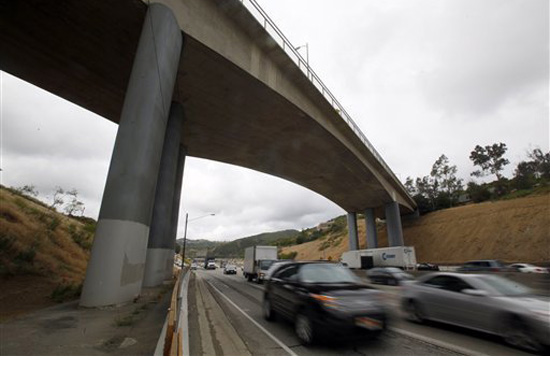
Editor’s note: These tips from the original Carmageddon could still be useful this time around. The dates have changed, of course; the 405 closure is Sept. 29-30.
In case you haven’t heard, official Los Angeles wants you to get out of town the weekend of July 15-18, or to make it a stay-close-to-home time as demolition of the Mulholland Bridge shuts down the 405 Freeway. For those of you planning to tough it out here in L.A., we asked some of our county colleagues to help us compile tips for turning 53 hours of Carmageddon fever into some good communal karma. Here’s what we came up with:
Hunkering down
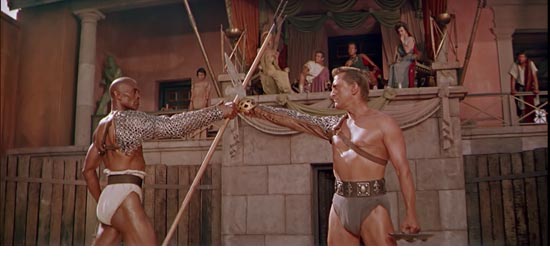
1. Honor the demise of the Mulholland Bridge by holding a mini-film festival of movies from 1960, the year it was completed. Some classic options include “Psycho” and “Spartacus.” Or see how far you can get, screening your way through AFI’s list of America’s 100 Greatest Movies.
2. Continue the mid-century theme by making a playlist that includes 1960 hits such as “It’s Now or Never” and “Only the Lonely.”
3. Adopt a pet from a local animal shelter, and spend the weekend introducing your newest family member to your home and neighborhood. Locate a nearby L.A. County shelter here; call ahead to find out whether they have animals ready for same-day adoption.
4. Dust off some old board games and hold a Clue, Scrabble or backgammon marathon. At least that little Monopoly car will still be able to zip around the board, even if the rest of Southern California is stuck in a weekend-long Sigalert.
5. Plan your next vacation(s).
6. While away a few hours perusing the Los Angeles Public Library’s digital collections of old movie posters, travel posters, fruit crate labels and photographs. (Just type in a keyword such as “Hollywood” and a year span of, say, 1959-1960, and start feasting your eyes on some amazing shots.)
7. Join Los Angeles Times architecture critic Christopher Hawthorne in his yearlong “Reading L.A.” project. The July titles include “The History of Forgetting: Los Angeles and the Erasure of Memory” and “Holy Land: A Suburban Memoir.”
8. Get an early jump on your holiday shopping without getting out of your pajamas by patronizing some of these L.A. County online stores.
9. Get organized, and do some good at the same time: Clean out your pantry and donate non-expired canned goods to a food bank. Go through closets for items to give to a charitable thrift shop. Gather up loose change and earmark the proceeds for a cause you care about.
10. Take this quiz and see if your kitchen could earn an “A” from county public health inspectors.
11. Make sure you have emergency kits in your car and at home. Check out the Department of Public Health’s emergency preparedness site for its list of 10 essential items. Update your family emergency preparedness plan and practice it. And while you’re at it, check out the county Fire Department’s fire prevention resources, too.
Building community

12. If you have a pool, invite your neighbors over for a swim and an outdoor movie.
13. Go door-to-door and collect neighbors’ phone numbers and email contacts for an emergency phone tree.
14. Organize a block party.
15. Buy a large canvas and set it on an easel in front of your house along with paints, brushes and a sign asking passersby to get artistic.
16. Enlist your neighbors in a community walking group.
17. Start a Neighborhood Watch group.
18. Drop by your local fire, police or sheriff’s station and say hello.
19. Take an interest in where your neighborhood lands in the county’s redistricting process by weighing in here. The Board of Supervisors is expected to adopt a redistricting plan by August, 2011.
20. Make a list of 10 people you haven’t spoken to in a long time and call them to say hello. Better yet, surprise each of them with a handwritten letter.
21. Check in on a sick or elderly neighbor and offer your services in the yard, kitchen or laundry room, or as an errand-runner for the afternoon. A ride to religious services might be appreciated, too.
22. Form a neighborhood group to ride in the new northbound 405 carpool lane that will stretch from the 10 to the 101 when the Sepulveda Pass project wraps up in 2013…and share the gain that comes after the pain.
Out and about

23. Be the first on your block to experience the Natural History Museum’s spectacular new Dinosaur Hall, which opens July 16. Public transportation options are probably best; find them here.
24. Frolic in a local park. Los Angeles County has more than 150 of them, so pack your Frisbee and a picnic and enjoy the summertime weather with your family. More information about park locations and amenities is here.
25. Get a library card. Or, if you already have one, make it a point to drop by over the weekend and learn about opportunities for volunteering or donating.
26. Get a group together for a Metrolink daytrip. San Juan Capistrano, anyone? Check out the station map here for other possible destinations.
27. Plug your address into www.walkscore.com and find out how walkable your neighborhood is. Then start hoofing it.
28. Patronize locally-owned businesses. (Many will show up, along with other amenities such as parks, on Walk Score, above.)
29. Take a hike. Trail systems in Los Angeles range from easy strolls to challenging hillsides. Find one that’s close to you.
30. Hit the links at a county golf course. Skip the cart rental and enjoy the walk.
31. Stock up on healthy fruits and vegetables at your local farmers market.
32. Grab your camera and head out in search of your neighborhood’s most distinctive features, from lampposts and architecture to flowerbeds and wildlife. Share your photos on Supervisor Yaroslavsky’s website.
33. Whether your taste in entertainment runs more to “Shrek The Musical” at the Pantages or Sarah McLachlan at the Hollywood Bowl or “Les Misérables” at the Ahmanson, there’s a way to get there by public transportation. And this is just the weekend to give it a try.
Make it a green weekend

34. Tear out your lawn and replace it with native plants.
35. Plant a tree. Or outsource the work to TreePeople, in honor of someone you love.
36. Start a garden. The benefits—fresh air, exercise—will go well beyond the tasty vegetables and herbs you’ll harvest. Tips are here.
37. If you’ve already got a garden, host a garden party (fancy hats optional) and send everybody home with a cutting.
38. Organize or join a produce-sharing cooperative on your block…and start off by pooling backyard lemons and making a giant batch of lemonade for everyone to share.
39. Start a backyard compost pile. (Read up first on all the benefits here.)
40. Get in line for some green by signing up your house for Energy Upgrade California at www.lacountyenergyprogram.org
41. Calculate your home’s solar energy potential.
42. Grab your reusable shopping bags and flaunt them everywhere you shop in honor of the county’s new plastic bag ban.
43. If you live near the beach, or can get there on the bus, take to the sand and help clean it up. For a list of more organized clean-up activities, look here.
44. Find out how and where to get rid of used motor oil or old computers and other “e-waste.”
45. Install some eco- and design-friendly rainbarrels to store rainwater from your roof for future use. (More information starts on Page 27 of this county manual.)
Go car-free for a day—or forever
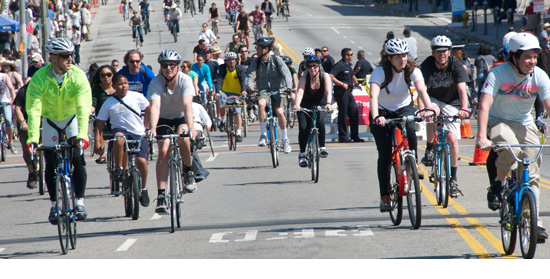
46. Ride the subway for free all weekend long. Update: There are no free rides for Carmageddon II.
47. Explore a wealth of summer destinations on public transportation.
48. While you’re riding, check out the art. Or really save energy and check out Metro’s art virtually.
49. Go out to eat without guzzling gas. The possibilities range from pastrami to rice porridge on Metro’s Dining Map.
50. Help plan and promote the next car-free CicLAvia.
51. Look up the bike trail that’s nearest to your house, and give it a try. Detailed path maps are here.
52. Get a pedestrian’s eye view of L.A. history by following one of these self-guided Angel’s Walk itineraries. Other downtown walks are here.
53. Practice riding your bike to work …and then when Monday rolls around, really do it. And congratulations, you made it through 53 hours without the 405 Freeway!
Posted 6/15/11
The sheriff vs. the probation chief
July 12, 2011
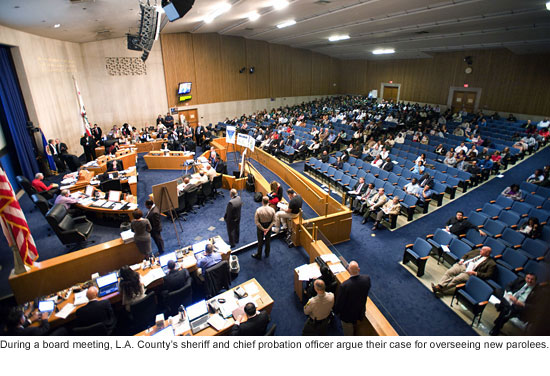 Two of Los Angeles’ most powerful criminal justice agencies faced off Tuesday during an extraordinary meeting of the Board of Supervisors, each arguing that they’d be better equipped to handle the surge of parolees who’ll soon be flowing into the county as a result of the state’s budget crisis.
Two of Los Angeles’ most powerful criminal justice agencies faced off Tuesday during an extraordinary meeting of the Board of Supervisors, each arguing that they’d be better equipped to handle the surge of parolees who’ll soon be flowing into the county as a result of the state’s budget crisis.
Under Gov. Brown’s “realignment” spending plan, California’s counties are being given responsibility for overseeing thousands of low-level state prison inmates who will be released to ease prison overcrowding and to save money. Although the state has agreed to provide funding to the counties for the first year, there are no guarantees beyond that.
Virtually everywhere else in the state, county probation departments have been tasked with these new duties, which are similar to those they already perform. But in Los Angeles, Sheriff Lee Baca has offered a novel and controversial proposal, contending that the public safety mandate of his department should be broadened to include the rehabilitative work of parole supervision.
On Tuesday, Baca took on Los Angeles County’s Chief Probation Officer Donald Blevins, who argued that his agency is not only more qualified to oversee the new parolees but that it can do so at a better price for taxpayers. The Board of Supervisors’ hearing room was crowded largely with Probation Department supporters.
The supervisors, who had strongly opposed Brown’s realignment proposal, challenged the two agency leaders to defend the content and cost of their proposals. Some expressed concerns that neither department—both of which have come under federal scrutiny for facets of their operations—could deliver on its promises. Several supervisors suggested that a hybrid of the two agencies should be considered. In the end, the board asked the Chief Executive Office to report back with an analysis of the competing proposals.
Critics of Baca’s bid contend that the Sheriff’s Department has no institutional expertise in overseeing parolees, a job more akin to social work because of its emphasis on reintegrating ex-prisoners into society. But the sheriff pointed to his record as a leading advocate for inmate rehabilitation and his department’s success in working with community-based re-entry programs.
“My department has the largest education-based incarceration program in the nation,” he said.
At the same time, Baca argued that the reach of his department could help protect the public from problems that might arise from such a large number of former inmates suddenly returning to live in Los Angeles County.
“This is a seven-day-a-week, 24-hour-a-day problem, and therefore resources must be dedicated to ensure that felons in the system understand we have the capacity to supervise them any time, any place, any time relative to the week,” Baca said.
Chief Probation Officer Blevins, for his part, acknowledged that his department has been plagued by problems in its juvenile camps. But he emphasized that it has an excellent record in supervising adults, many of whom are ex-felons and account for more than 70% of the department’s workload.
“We have a proven track record of working with this population,” Blevins said. Moreover, he said, the Probation Department could better comply with a legal mandate encompassed in the state legislation requiring the county to use “evidence-based” practices to reduce recidivism among state parolees. One probation program for probationers aged 18-25 at a county day reporting center has cut recidivism from 39% to less than 22%, he said.
The Probation Department’s plan, he said, “does not focus on suppression and incarceration over rehabilitation…It does not complicate and confuse the clients in terms of the roles and responsibilities of officers. It does not require building, learning and training to a brand new infrastructure that potentially can take years to implement and operate efficiently.”
Although the supervisors did not vote on the matter, several seemed openly wary of Baca’s plan, especially given its higher one-year cost estimate–$37 million versus $28 million for the Probation Department.
Supervisor Zev Yaroslavsky, for one, suggested that the board might not even be considering Baca’s proposal were it not for his reputation as one of law enforcement’s most forward-thinking figures.
“You’re unique, Lee,” the supervisor said told the sheriff. “The only reason this has been given the time of day is because you’re proposing it. If this had come from just about anybody else in law enforcement, I don’t think it would have been given serious consideration.”
Posted 7/12/11
Homeboy counting on a comeback
July 12, 2011
Last May, Homeboy Industries was in serious peril. The recession and a costly expansion had crippled the renowned gang intervention program financially. Three-quarters of its staff had been laid off and Father Gregory Boyle, Homeboy’s Jesuit founder, was relying on volunteers just to keep the doors open.
What a difference a year can make.
With a push for federal funding, a barrage of new initiatives, and—crucially—a key $1.3 million contract from Los Angeles County, “we’re still struggling, but we’re back on our feet,” says Veronica Vargas, Homeboy’s chief operating officer.
Not that they’re unscathed. The organization is accepting only about half the in-house job trainees it used to. Health insurance has been cut for trainees in its Chinatown headquarters. The waiting lists for tattoo removal, mental health care and other services are so long, “we’re doing triage,” says Vargas.
But in the past year, Homeboy, which says it helps 12,000 gang members a year with educational, mental health, legal and job training services, has not only dramatically ramped up its business, but also begun to see the fruits of a county-funded initiative to objectively measure the success of its programs.
“I’ll be blunt—so far, it’s not at all what I expected,” says Jorja Leap, one of two UCLA School of Public Affairs scholars who have been monitoring Homeboy both for a separate longitudinal study and as part of the county’s 9-month contract.
Since September, at the county’s behest, Homeboy has been providing job counseling and development, mental health care, tattoo removal and other services for 665 probationers and other high-risk individuals between the ages of 14 and 30. This week, Leap and her colleague, Todd Franke, submitted the second of three progress reports to the county.
Six months into the contract, Leap says, demand has been strong—and growing, particularly among county probationers and parolees under 30. Early figures show that about 100 county clients per month have volunteered for tattoo removal, and about 300 a month have been taking advantage of Homeboy’s employment counseling services. Another 150 or so each month have attended life skills, GED, 12-step and other classes.
Those numbers—and that word “volunteer”—are important because they reflect the extent to which the county might, over time, reduce duplication between Homeboy and its own gang re-entry programs.
Cal Remington, chief deputy of the county’s Department of Probation, says the reports have been encouraging so far, and Homeboy’s success is well-known, but savings ultimately could be limited.
 For example, he says, most Homeboy programs are based on the belief that people don’t change unless they want to, and the organization “wants people to come on their own.” But probation and parole are, by their nature, involuntary. Many probationers and parolees do seek out Homeboy, he says, but unless the entire county caseload volunteered, some would still require county-run re-entry programs.
For example, he says, most Homeboy programs are based on the belief that people don’t change unless they want to, and the organization “wants people to come on their own.” But probation and parole are, by their nature, involuntary. Many probationers and parolees do seek out Homeboy, he says, but unless the entire county caseload volunteered, some would still require county-run re-entry programs.
“I think they provide a real service that benefits the county,” he says, “but we’re interested in finding out how many [probationers] voluntarily take advantage of that, and then how they’re doing in the community.”
Additionally, the report has tracked a smaller cohort of job trainees whose positions are also funded under the county contract.
So far, Leap says, about 50 former gang members, two-third of them male, have cycled through those 30 trainee positions. And though gang populations nationally have a 70% recidivism rate, she says, only three of the county’s Homeboy trainees have been re-arrested and none have gone back to prison so far.
On the other hand, she says, one of the 50 has now entered college, four have gone on to full-time jobs with employers outside Homeboy, about 20 have worked their way up to employment at one of Homeboy’s various businesses and another 22 or so are continuing to progress through the program.
Leap cautioned that the numbers are preliminary. And, she says, the data has not yet come in for a planned comparison with retention and recidivism rates in two county-run gang re-entry programs.
“But,” she says, “you don’t need a Ph.D to tell you that these are phenomenal, phenomenal results.”
“This is why I can’t wait for the county to see how well this program works,” exults Vargas. “Nobody back in prison? That’s huge.”
Although four outside placements and a college enrollment may not sound like much after six months, she says, just sticking with the program is an achievement for many gang members.
One young man profiled in Leap’s report had come to the Homeboy program after an 18-month stint in state prison on an armed robbery conviction. The son of a drug-addicted mother and absentee father, he had grown up in a 3-bedroom apartment shared by 30 people in the Nickerson Gardens Housing Project.
He had thrived as a Homeboy trainee, the report says, and was working with young adults just out of probation camps within three months of his arrival. But his family’s gang ties were a constant source of conflict.
“Some family members would openly mock his efforts, while other relatives would pressure him to get back involved in the streets and the gang life style,” the report says. For a while, the young man slept in his car to escape the pressure, but his struggle has been apparent.
“He continues to be an excellent worker,” according to the report, but “he has not kept all his appointments and seems very conflicted about gang involvement.”
It’s a common pattern, says Vargas. Indeed, one of the county-funded trainees—a 22-year-old who had diligently worked his way up to an office assistant job at Homeboy—was shot and killed last month at a late-night party in Hollywood during what authorities said was a gang-related argument.
According to Leap’s report, the vast majority of Homeboy’s clients are county probationers and parolees who are struggling to regain their footing. Many have spent years in and out of probation camps where, the report notes, they missed out on learning even such basic life skills as how to look employers in the eye and offer a firm handshake.
“Says Vargas: “You can’t rehabilitate someone in six months when they’ve been raised all their lives in violence.”
This, she says, is why she hopes the county will consider renewing its relationship with Homeboy when the current contract expires at the end of next month.
That may not be easy, given the county’s own struggles.
“As you know, we have our own deficit to deal with,” says Sheila Williams, who helps oversee the county’s public safety agencies for the Chief Executive Office. But, she adds, so far, there have been no complaints about Homeboy’s performance and “discussions are continuing.”
Meanwhile, Vargas says, Homeboy has been hustling.
The organization has won a federal grant that will to bring in about $400,000 a year for the next three years. Father Boyle has been on a book tour, promoting his acclaimed memoir, “Tattoos on the Heart: The Power of Boundless Compassion” ; those proceeds all go to Homeboy as well, Vargas says.
Ralph’s markets began offering Homeboy’s signature chips and salsas in its supermarkets nationally this year, and another initiative is promoting Homeboy products at farmers’ markets.
The conviction of KB Home’s former chief executive, Bruce Karatz, on charges that he lied about backdating stock options resulted in an unusual sentence in which Karatz—who in the run-up to his trial had already pledged $1.1 million to the organization—would bring his experience and contacts to bear as an unpaid Homeboy consultant. Vargas says they’ve only received about $200,000 of the pledge so far, but credits Karatz with the nailing the Ralph’s salsa deal in just a few phone calls after years of conversations.
And City Hall will soon be getting a new Homeboy café.
“We’re doing everything we can think of,” Vargas says. “We have to. You should see our waiting list.
“There are hundreds of people coming through our doors every month, asking for employment, and right now, we can’t provide it for them.”
Posted 5/5/11
Hall of Justice to reopen in 2014
July 10, 2011
 Los Angeles’ long-slumbering Hall of Justice just moved closer to a 2014 reawakening as a new home for the Sheriff’s Department and members of the District Attorney’s staff.
Los Angeles’ long-slumbering Hall of Justice just moved closer to a 2014 reawakening as a new home for the Sheriff’s Department and members of the District Attorney’s staff.
The storied 1925 building, which played host to some of L.A.’s most famous and infamous figures, from Charles Manson and Sirhan Sirhan to Marilyn Monroe after her death, has been closed since the Northridge earthquake in 1994.
Since then, workers have virtually gutted the space to set the stage for the hall’s revival. On Tuesday, the Board of Supervisors approved a design-build contractor, Clark Construction Group California LP, to finish the job.
The board’s action set the budget for the project at $231,785,000. Long term bonds were issued to fund the project in November. A report submitted to supervisors said the debt service on the bonds would be more than covered by lease savings realized by moving staff into the rehabilitated building. Over 30 years, the net lease savings would be $160,300,000, the report said.
When finished, the building will feature 308,000 square feet of office space and a 1,000-space parking structure.
Clark is set to begin design-build work next month. The report said the company has offered to upgrade the finished building’s environmental ranking from LEED Silver to LEED Gold at no additional cost to the county.
To get a look at the Hall of Justice’s historic interior as it awaits transformation, check out this flashlight tour.
Posted 7/12/11
Start mapping your 405 getaway
July 8, 2011
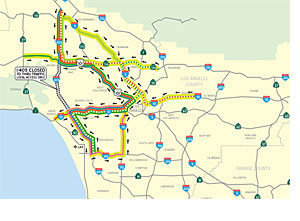 The latest ramp closure and detour maps for the 53-hour shutdown of the 405 Freeway have been finalized and feature a Sepulveda Boulevard route through the closure zone that will be designated for locals only.
The latest ramp closure and detour maps for the 53-hour shutdown of the 405 Freeway have been finalized and feature a Sepulveda Boulevard route through the closure zone that will be designated for locals only.
The four maps include a regional overview showing how the closure will affect freeways throughout Los Angeles County, up-close views of specific ramp closures (one for the northbound freeway and the other for the southbound) along with a detour map indicating recommended routes around the segment of the 405 that will be closed so workers can demolish the south side of the Mulholland Bridge over the freeway.
Notably, Sepulveda Boulevard between the 10 and 101 Freeways is marked as being closed to through traffic and will be designated as reserved for local access only, according to the draft map. However, Ron Macias, a community relations officer for the project, said there are no plans to check IDs to ensure that only residents are using the street. “We cannot prevent anyone from using Sepulveda, but it’s going to be gridlocked,” he said, noting that Metro is strongly encouraging motorists to stay far away from the area.
Ramps will begin closing around 7 p.m. on Friday, July 15. The entire freeway will be closed all of Saturday, July 16, and Sunday, July 17. It is expected to be reopened by 5 a.m. on Monday, July 18.
Posted 6/2/11
Dance without limitations
July 7, 2011
There’s more than one way to cut a rug. Dancers of all ages–with and without disabilities–star in barrier-breaking contemporary routines this Saturday at the Ford Amphitheatre in the latest installment of the “Big!World!Fun!” family series.
AXIS Dance Company began producing “physically integrated” dance in 1987, and has since staged routines across the United States and worldwide, featuring dancers with prosthetics and in wheelchairs, as well as those without disabilities. Over the years it has been awarded multiple Isadora Duncan Dance Awards (Izzies), and has been featured in local and national broadcasts.
The Big!World!Fun! series, sponsored in part by Supervisor Zev Yaroslavsky, brings music, dancing and theatre to families in eight morning performances that are free for kids. The Ford’s 2011 programming is produced by the Los Angeles County Arts Commission and aims to promote diverse artistic performances to diverse audiences.
See AXIS do its thing this Saturday, July 9, at 10:00 a.m., or come at 9:00 a.m. for pre-show dance and exercise led by Family Dance Jam. The Ford is located at 2580 Cahuenga Blvd. East–directions are available online. Adult tickets are just $5, and kids under 12 get in for free. Reservations are required, so make them online or by calling (323) 461-3673. Parking costs $1.
Posted 7/7/11
All of WeHo’s a stage
July 7, 2011

Merry wanderers of the night, make your way to Plummer Park for an adaptation of Will Shakespeare’s As You Like It. This Saturday, July 9, marks the first in a series of free outdoor summer performances of the play, sponsored by the City of West Hollywood. They will continue on Saturdays and Sundays until August 14; the full schedule is on the city’s website.
This 90-minute musical adaptation of the Bard’s classic comedy was written by the Tony Award-nominated Tony Tanner, and is staged by the Classical Theatre Lab, which provides an outlet for professional actors to perform works by history’s greatest writers.
Seating is limited, so reserve your spot by calling (323) 960-5691 or TTD (323) 848-6496. Plummer Park is located at 7377 Santa Monica Boulevard. This weekend’s shows begin at 6 p.m. Get there with Metro and skip the search for parking.
Posted 7/7/11
Dinosaurs roar back to life at exhibit
July 7, 2011
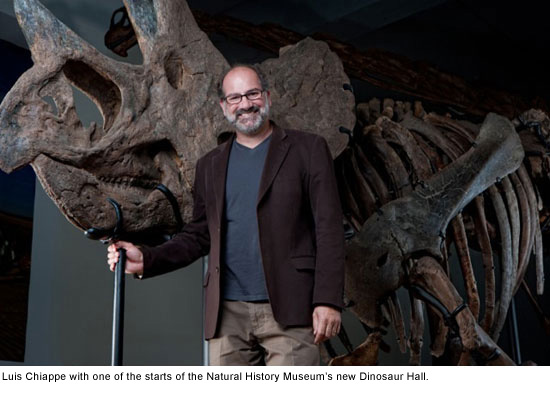 Their body temperatures were almost the same as a human’s. Some had plumage and the ability to make noises. Some had footprints and tail shapes about which we were wrong until recently.
Their body temperatures were almost the same as a human’s. Some had plumage and the ability to make noises. Some had footprints and tail shapes about which we were wrong until recently.
We’re fairly sure about what killed them (fallout from a meteor crash) and what they evolved into. (Hint: It has feathers). But much of their 230 million years on the planet remains a mystery.
You could fill an encyclopedia with what scientists are still discovering about dinosaurs. But for the past several years, Luis Chiappe, director of the Dinosaur Institute at the Los Angeles County Natural History Museum, has had something even bigger in mind.
This month, a newly renovated, 14,000-square-foot Dinosaur Hall will open, doubling the dinosaur display space at the museum. The permanent exhibition, which opens to members July 10 and to the general public July 16, will feature some 20 new major mountings from the museum’s expanded collection—from an extraordinary trio of young Tyrannosaurus rex skeletons to the smallest dinosaur ever discovered in North America. It also will reflect the ways in which technology has revolutionized paleontological research.
“This is not a chronological journey through time, and this is not setting animals in dioramas,” says Chiappe, who led much of the fieldwork responsible for the exhibit and curated it as an invitation to visitors to regard the towering fossils with a scientific eye.
“This is, ‘How do we know what we know? How do we reconstruct the life and, in the end, the death of these animals?’ This is an up-to-date, state-of-the-art understanding of the lives of the dinosaurs.”
In other words, this is not your father’s dinosaur museum. The new Dinosaur Hall will fill two rooms with nearly 300 specimens collected over nearly a century, with at least a third of the major pieces never before having been shown to the general public.
Displays will include background on how technological advances such as CT scans and particle accelerators have, for example, helped scientists understand the internal organs of dinosaurs and deduce the original colors of their skin and feathers. Many of the pieces have yielded important new discoveries and resulted in published research.
“Some amazing things were unearthed in the course of doing this hall,” says John A. Long, vice president of research and collections at the museum, which operates not just as a showcase, but also as a major research institution.
And, Long adds, because of improvements in conservation methods, “you can see the bones better—they’re better prepared.”
Among the showpieces will be the dramatic grouping of young T. rex skeletons—baby, early adolescent and teenager—that, taken together, make up the world’s only depiction of the famous carnivore’s growth pattern.
Also featured will be one of the most anatomically accurate depictions to date of the massive Triceratops, culled from several finds that included a completely articulated set of front leg, or “arm”, bones—a rarity that has contributed a fresh understanding of how the massive creature walked and lived.
Both the Triceratops bones and the oldest T. rex—a gangly, 33½-foot-tall teenager nicknamed “Thomas” that boasts one of the most complete skeletons in existence—were collected by Chiappe and his crews during field work in Wyoming and Montana. But the displays also include the museum’s very first specimen (a lower jaw from a Canadian duck-billed dinosaur that was collected in 1919), and a number of significant finds collected for the museum by the late Harley Garbani, a self-taught fossil hunter from Hemet who died at 88 in April.
”He toured the galleries a couple of months ago, but it would have been wonderful if he could have been around for the opening,” Chiappe says wistfully.
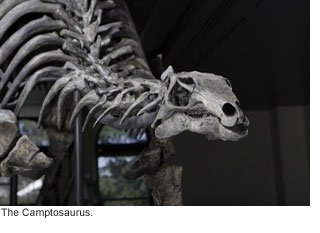 Additionally, there are killer sea reptiles known as Mosasaurs, who, upon closer inspection by Chiappe and his colleagues were recently found to have had flukes, not long, tapering tails as scientists once imagined. Chiappe and Long say the information was there all along, but no one noticed it because the fossils had been in storage since they were found in Kansas and acquired during the 1960s.
Additionally, there are killer sea reptiles known as Mosasaurs, who, upon closer inspection by Chiappe and his colleagues were recently found to have had flukes, not long, tapering tails as scientists once imagined. Chiappe and Long say the information was there all along, but no one noticed it because the fossils had been in storage since they were found in Kansas and acquired during the 1960s.
“We have one of the best specimens in the world,” Long says, “and it had been locked up until we dusted it off and prepared it for this gallery. In doing so, we found skin and pigments and bronchial tubes and a wealth of new information, including a big tail fluke, like a tuna or a shark, that changes what we know about the way they swam and hunted.” (Stay tuned for further developments on this front. Museum sources say another blockbuster announcement about this part of the exhibit could come within the next few weeks.)
The Dinosaur Hall is part of an ambitious plan to expand and modernize the Natural History Museum, which celebrates its centennial in 2013. A groundbreaking “Age of Mammals” exhibition opened last year; a new California history hall and several other permanent exhibitions, including a 63-foot-long fin whale specimen, are anticipated before the end of next year.
Chiappe, an internationally renowned paleontologist who was recruited 12 years ago from New York’s American Museum of Natural History to supervise Los Angeles’ dinosaur collection, says the permanent exhibit had been under consideration almost from the moment of his arrival, “but we’ve worked intensively in the last five or six years.”
A native of Argentina, Chiappe says he grew up as “a city boy” in Buenos Aires, but learned from his grandfather to love the outdoors.
“We’d go hunting and fishing,” he recalls. “For a while, I wanted to be a biologist, and I went to university with that in mind. But then I met a classmate who was into paleontology, and we started going out on weekends, collecting Ice Age fossils, like saber-toothed cats and mastodons, amazing animals that don’t exist anymore. I thought it was incredibly cool.”
Chiappe has since done extensive fieldwork and research, particularly into the evolutionary links between dinosaurs and their modern counterparts, birds. The Dinosaur Hall also will address those connections.
“We will have a taxidermy pelican in a glass case, and a swan, an ostrich and a pelican skeleton,” he says. We will have a mural featuring emus, and we’ll talk about hummingbirds as dinosaurs—the idea that dinosaurs are in your backyard, and if you want to see one today, they’re right outside their window. You only need to look.”
Chiappe’s favorite displays? Well, he says, his favorite dinosaur is T. rex, and his 4 1/2-year-old son’s is Triceratops. But No. 1 on his Dinosaur Hall hit parade is the “Fossil Wall,” a 43-foot display case with nearly 100 specimens, from dinosaur bones and droppings to dinosaur eggs and skin.
“It’s beautiful from an aesthetic point of view,” he says, “and it expresses the wealth of our collection—it’s really an art installation using dinosaur body parts.”
What does he hope the public will glean from the museum’s scientific take on his favorite subject?
“I’d like people to understand that they were living animals,” he says. “We know them as skeletons. We see their bones in museums. But they were alive once. They suffered and had illnesses and diseases, and found mates and reproduced and did everything we associate with living animals, whether they are our pets or ourselves.”
Long, a fellow paleontologist who came to the museum two years ago from Australia, calls the new Dinosaur Hall “one of the most exciting dinosaur exhibits in the world,” and says it has been “a dream come true to be part of a team presenting a gallery like this.”
But, he adds, “this really is Luis’ baby.”
“It’s obviously once in a lifetime that a curator is essentially setting the course on the steering wheel for a major exhibit like this,” agrees Chiappe. “I know I won’t have another opportunity like this.”
Posted 7/7/11





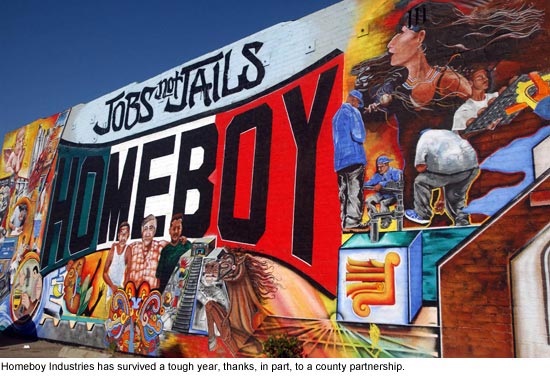

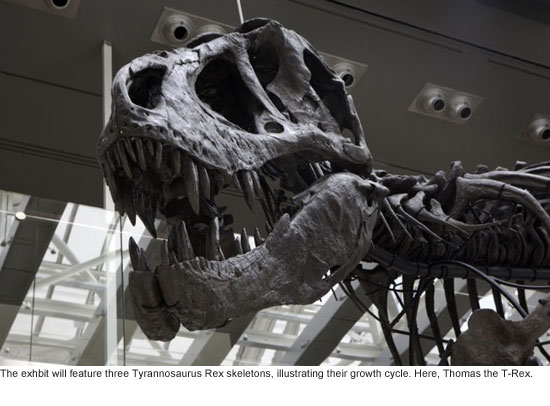





 Check for the latest closure information
Check for the latest closure information








